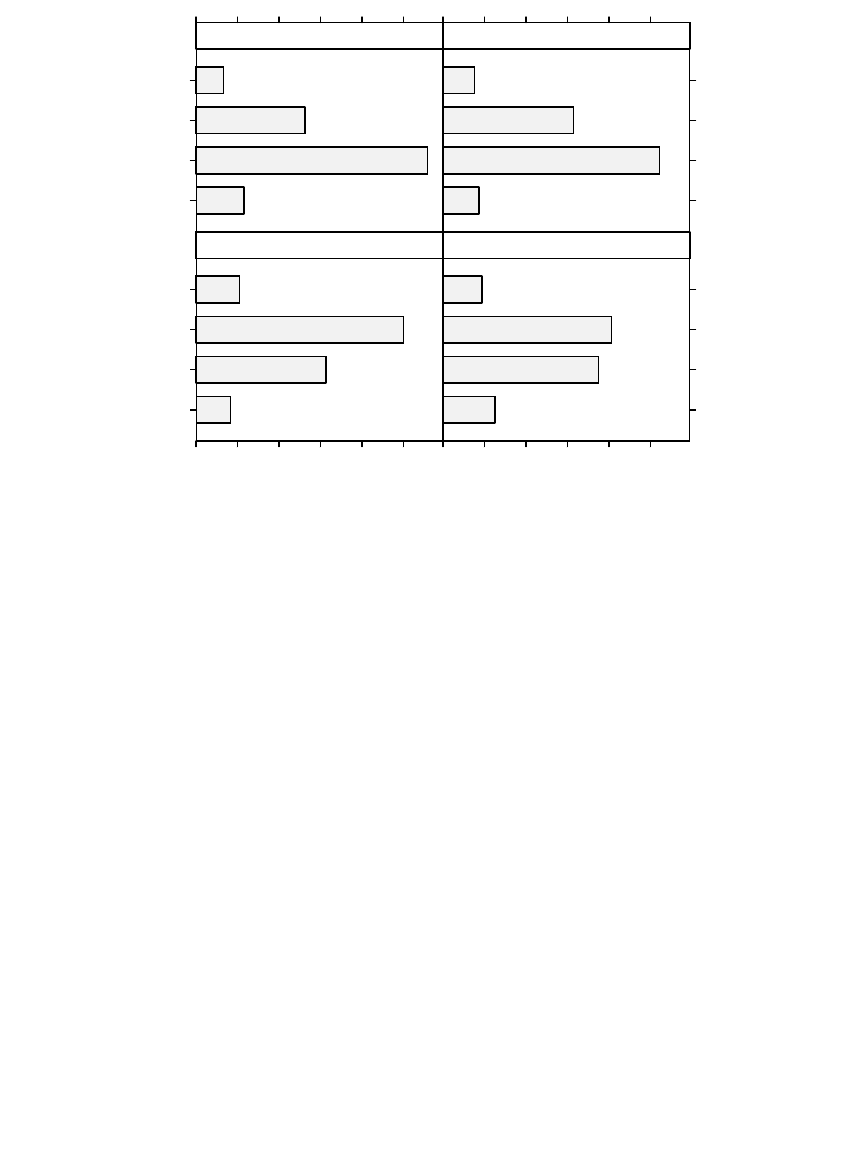Short T.A. Electric Power Distribution Handbook
Подождите немного. Документ загружается.


Short-Circuit Protection 427
• Recloser fuse saving — Fault currents are lower downstream, and
reclosers are faster, so fuse saving should work well here.
The high-low scheme is easy to implement. The station instantaneous trip
is eliminated. Reclosers are operated with a fast trip (the A curve). Most are
already in this mode, so no changes are necessary here.
8.3.3 SCADA Control of the Protection Scheme
Another option is to use SCADA to change back and forth between fuse
saving and fuse blowing, getting some of the benefits of both schemes. Fuse
blowing is the normal operating mode, but operators could switch to a fuse
saving scheme during storms. This avoids clear-sky momentaries while at
the same time improving storm restoration. Several factors make fuse saving
better during storms:
• Faults are more likely to be temporary during storms (lightning, wind).
• Customers are more forgiving about momentaries during storms.
• Interruptions due to fuse operations last longer during storms
(because crews have many repairs to perform). If fuses are blown
due to temporary faults, this increases the number of repair loca-
tions. Saving fuses reduces the number of interruptions crews will
have to address.
In order for SCADA control of fuse saving to work best, we must design
the system for fuse saving to work: larger, slower fuses for laterals close to
the substation, faster circuit breakers (or use substation reclosers), or possibly
even using grounding reactors in the substation to limit fault currents. Like-
wise, we must design for fuse blowing, so avoid using tree wire (or go to
delayed instantaneous relaying rather than removing the instantaneous trip).
Control is more readily available in the substation because the SCADA
infrastructure may already be in place. If so, the cost of the SCADA system
has already been justified, and this added functionality could be piggy-
backed on the existing system if there are free channels available. It is feasible
to use automation technology to implement remote control of feeder reclos-
ers, but the cost of the communication equipment may not justify having
this functionality.
For SCADA control, microprocessor-controlled relays are not needed. A
SCADA channel can be used to control a blocking relay on the instantaneous
elements of the feeder relays. Alternatively, the SCADA channel could con-
trol the delay on the instantaneous relay element (no delay: fuse saving, with
delay: fuse blowing). One SCADA channel could control the fuse saving/
blowing status of all of the distribution feeders in a station. Alternatively,
we could control each feeder independently.
1791_book.fm Page 427 Monday, August 4, 2003 3:20 PM
(C) 2004 by CRC Press LLC

428 Electric Power Distribution Handbook
8.8.4 Adaptive Control by Phases
Various protection schemes are classified as adaptive. An adaptive approach
to a fuse blowing mode is to adjust the scheme depending on how many
phases are faulted:
• 2- or 3-phase fault — Use the instantaneous; the fault is assumed to
be on the 3-phase mains. Tripping quickly reduces the duration of
voltage sags for faults on the mains.
• Single-phase fault — Use fuse blowing (time delay curves or delayed
instantaneous relay).
Adaptive control requires microprocessor-based relays. This is not a com-
mon scheme, and the expense and complexity are difficult to justify unless
the chosen relay comes with this functionality.
8.9 Reclosing Practices
Automatic reclosing is a universally accepted practice on most overhead
distribution feeders. On overhead circuits, 50 to 80% of faults are temporary,
so if a circuit breaker or recloser clears a fault and it recloses, most of the time
the fault is gone, and customers do not lose power for an extended period
of time.
On underground circuits, since virtually all faults are permanent, we do
not reclose. A circuit might be considered underground if something like
60 to 80% of the circuit is underground. Utility practices vary considerably
relative to the exact percentage (IEEE Working Group on Distribution Pro-
tection, 1995). A significant number of utilities treat a circuit as under-
ground if as little as 20% is underground while some others put the
threshold over 80%.
The first reclose usually happens with a very short delay, either an imme-
diate reclose which means a 1/3- to 1/2-sec dead time (discussed later) or
with a 1- to 5-sec delay. Subsequent reclose attempts follow longer delays.
The nomenclature is usually stated as 0–15–30 meaning there are three
reclose attempts: the first reclose indicated by the “0” is made after no
intentional delay (this is an immediate reclose), the second attempt is made
following a 15-sec dead time, and the final attempt is made after a 30-sec
dead time. If the fault is still present, the circuit opens and locks open. We
also find this specified using circuit breaker terminology as O-0 sec-CO-15
sec-CO-30 sec-CO where “C” means close and “O” means open. Other com-
mon cycles that utilities use are 0–30–60–90 and 5–45.
With reclosers and reclosing relays on circuit breakers, the reclosing
sequence is reset after an interval that is normally adjustable. This interval
1791_book.fm Page 428 Monday, August 4, 2003 3:20 PM
(C) 2004 by CRC Press LLC

Short-Circuit Protection 429
is generally set somewhere in the range of 10 sec to 2 min. Only a few utilities
have reported excessive operations without lockout (IEEE Working Group
on Distribution Protection, 1995).
8.9.1 Reclose Attempts and Dead Times
Three reclose attempts is most common as shown in Figure 8.20. More reclose
attempts give the fault more chance to clear or burn free. Returns diminish;
the chance that the third or fourth reclose attempt is successful is usually
small. Additional reclose attempts have the following negative impacts on
the system:
• Additional damage at the fault location — With each reclose into a fault,
arcing does additional damage at the fault location. Faults in equip-
ment do more damage. Cable faults are harder to splice, wire burn-
downs are more likely, and oil-filled equipment is more likely to
rupture. Arcs can start fires. Faults (and the damage the arcs cause)
can propagate from one phase to other phases.
• Voltage sags — With each reclose into a fault, customers on adjacent
circuits are hit with another voltage sag. It can be argued that the
FIGURE 8.20
IEEE survey results on the number of reclose attempts for each voltage class. (Data from [IEEE
Working Group on Distribution Protection, 1995].)
Percent
Number of attempts
4
3
2
1
01020304050
25 kV
01020304050
35 kV
4
3
2
1
5 kV 15 kV
1791_book.fm Page 429 Monday, August 4, 2003 3:20 PM
(C) 2004 by CRC Press LLC

430 Electric Power Distribution Handbook
magnitude and duration of the sag should be about the same, so
depending on the type of device, if the customer equipment sur-
vived the first sag, it will probably ride through subsequent sags
of the same severity. If additional phases become involved in the
fault, the voltage sag is more severe.
• Through-fault damage to transformers — Each fault subjects transform-
ers to mechanical and thermal stresses. Virginia Power changed
their reclosing practices because of excessive transformer failures
on their 34.5-kV station transformers due to through faults (Johnston
et al., 1978).
• Through-fault damage to other equipment — Cables, wires, and especially
connectors suffer the thermal and mechanical stresses of the fault.
• Interrupt ratings of breakers — Circuit breakers must be derated if the
reclose cycle involves more than one reclose attempt within 15 sec.
This may be a consideration if fault currents are high and breakers
are near their ratings. Reclosers do not have to be derated for a
complete four-sequence operation. Extra reclose attempts increase
the number of operations, which means more frequent breakers and
reclosers maintenance.
• Ratcheting of overcurrent relays — An induction relay disc turns in
response to fault current. After the fault is over, it takes time for the
disc to spin back to the neutral position. If this reset is not completed,
and another fault occurs, the disc starts spinning from its existing
condition, making the relay operate faster than it should. The most
common problem area is miscoordination of a substation feeder
relay with a downstream feeder recloser. If a fault occurs down-
stream of the recloser, the induction relay will spin due to the current
(but not operate if it is properly coordinated). Multiple recloses by
the recloser could ratchet the station relay enough to falsely trip the
relay. The normal solution is to take the ratcheting into account when
coordinating the relay and recloser, but in some cases modification
of the reclosing cycle of the recloser is an option. Another option is
to use digital relays, which do not ratchet in this manner.
Given these concerns, the trend has been to decrease the number of reclose
attempts. We try to balance the loss in reliability against the problems caused
by extra reclose attempts. A major question is how often are the extra reclose
attempts successful. Table 8.15 shows the success rate for one utility in a
high-lightning area. Table 8.16 shows a second utility with similar reclosing
practices but quite different reclose success (more lockouts and lower success
rates for the first two reclose attempts). Reclose success rates change based
on the types of faults most commonly seen in a region. Another data point
with a broader distribution of utilities is obtained in the EPRI distribution
power quality study. Table 8.17 shows the number of momentary interrup-
tions (reclose attempts) that do not lead to sustained interruptions (lockouts).
1791_book.fm Page 430 Monday, August 4, 2003 3:20 PM
(C) 2004 by CRC Press LLC

Short-Circuit Protection 431
The key point is that it is relatively uncommon (but not rare) for the third
or fourth reclose attempt to be successful.
We may block reclosing in some cases. It is common to block all reclose
attempts when workers are doing maintenance on a circuit to provide an
extra level of protection (an instantaneous relay element is also commonly
enabled in this situation). Another situation is for very high-current faults.
A high-set instantaneous relay covering just the first few hundred feet of
circuit detects faults on the substation exit cables. If it operates, reclosing is
TABLE 8.15
Reclose Success Rates for a Utility in a High
Lightning Area
Reclosure Success Rate Cumulative Success
1st shot (immediate) 83.25% 83.25%
2nd shot (15 to 45 sec) 10.05% 93.30%
3rd shot (120 sec) 1.42% 94.72%
Locked out 5.28%
Source: Westinghouse Electric Corporation, Applied Protective Re-
laying, 1982.
TABLE 8.16
Reclose Success Rates for One 34.5-kV Utility
Reclosure Success Rate Cumulative Success
1st shot (immediate) 25.3% 25.3%
2nd shot (15 sec) 42.1% 67.4%
3rd shot (80 sec) 11.6% 79.0%
Locked out 21.0%
Source: Johnston, L., Tweed, N. B., Ward, D. J., and Burke, J. J.,
“An Analysis of Vepco’s 34.5 kV Distribution Feeder Faults as
Related to Through Fault Failures of Substation Transform-
ers,” IEEE Transactions on Power Apparatus and Systems, vol.
PAS-97, no. 5, pp. 1876–84, 1978. With permission. ©1978 IEEE.
TABLE 8.17
Number of Interruptions per One
Minute Aggregate Period that Do Not
Lead to Sustained Interruptions
Number Percentage
1 87%
2 9%
3 2%
4 or more 2%
Source: EPRI TR-106294-V2, An Assessment of
Distribution System Power Quality: Volume 2:
Statistical Summary Report, Electric Power Re-
search Institute, Palo Alto, CA, 1996.
1791_book.fm Page 431 Monday, August 4, 2003 3:20 PM
(C) 2004 by CRC Press LLC

432 Electric Power Distribution Handbook
disabled. This practice is done to reduce the damage for a failure of one of
the station exit cables.
The duration of the open interval — the dead time between reclose
attempts — is also a consideration. For a smaller number of reclose attempts,
use longer delays to give tree branches and other material more time to clear.
Operator practices must also be considered as part of the reclosing scheme.
Not uncommonly, an operator manually recloses the circuit breaker after a
feeder lockout (especially during a storm). This sends the breaker or recloser
through its whole reclosing cycle along with all of the bad effects (like more
equipment damage and more voltage sags) with very little chance of success.
Some engineers and field personnel believe that the purpose of the extra
reclose attempts is to burn the fault clear. This is dangerous. Faults regularly
burn clear on low-voltage systems (<480 V), rarely at distribution primary
voltages. Faults can burn clear on primary systems. The most common
example is that tree branches or animals can be burned loose. The problem
with this concept is that, just as easily, the fault burns the primary conductor,
which falls to the ground causing a high-impedance fault. Fires and equip-
ment damage are also more likely with the “burn clear” philosophy.
To reduce the impacts of subsequent reclose attempts, we could switch
back to an instantaneous operation after the first time-overcurrent relay
operation. If the fault does not clear after the first time-overcurrent relay
operation, it means the fault is not downstream of a fuse (or a recloser). The
reason to use a time overcurrent relay is to coordinate with the fuse. Since
the fuse is out of the picture, why not use a faster trip for subsequent reclose
attempts? While not commonly done, we could implement this with digital
relays. The setting of the “subsequent reclose” instantaneous relay element
should be different than the first-shot instantaneous. Set the pickup at the
pickup of the time-overcurrent relay. Because of inrush on subsequent
attempts, we may use a fast time-overcurrent curve or an instantaneous
element with a short delay (something like 5 cycles).
As an example, if a utility uses a 0–15–30–90 sec reclosing cycle, the system
is subjected to five faults if the system goes through its complete cycle. With
the instantaneous operation enabled on the first attempt and disabled on
subsequent attempts, we have a very high total duration of the fault current.
For a CO-11 ground relay with a time-dial of 3, a 2-kA fault clears in roughly
1 sec. For the reclosing cycle to lock out, the system has a total fault time of
4.1 sec (one 0.1-sec fault followed by four 1-sec faults). If the instantaneous
operation is enabled for reclose attempts 2 through 4, the total fault duration
is 1.4 sec (one 0.1-sec fault followed by a 1-sec fault and three 0.1-sec faults).
This greatly reduces the damage done by certain faults.
8.9.2 Immediate Reclose
An immediate reclose (also called an instantaneous or fast reclose) means
having no intentional time delay (or a very short time delay) on the first
1791_book.fm Page 432 Monday, August 4, 2003 3:20 PM
(C) 2004 by CRC Press LLC

Short-Circuit Protection 433
reclose attempt on circuit breakers and reclosers. Many residential devices
such as digital clocks, VCRs, and microwaves can ride through a 1/2-sec
interruption but not a 5-sec interruption, so a fast reclose helps reduce
residential complaints.
From a power quality point of view, a faster reclose is better. Some cus-
tomers may not notice anything more than a quick blink of the lights. Many
residential devices such as the digital clocks on alarm clocks, microwaves,
and VCRs can ride through a 1/2-sec interruption where they usually
cannot ride through a 5-sec interruption (a first reclose delay used by several
utilities).
8.9.2.1 Effect on Sensitive Residential Devices
The most common power quality recorder in the world is the digital clock.
Many complaints are due to the “blinking clocks.” Using an immediate
reclose reduces complaints. Florida Power has reported that a reclosing time
of 18 to 20 cycles nearly eliminates complaints (Dugan et al., May/June,
1996). Another utility that has successfully used the immediate reclose is
Long Island Lighting Company (now Keyspan) (Short and Ammon, 1997).
According to an IEEE survey, a time to first reclose of less than 1 sec is the
most common practice although the fast reclose practice tends to decline
with increasing voltage (see Figure 8.21).
FIGURE 8.21
IEEE survey results of the intervals used before the first reclose attempt for each voltage class.
(Data from [IEEE Working Group on Distribution Protection, 1995].)
Percent
Duration
> 5 seconds
1-5 seconds
0-1 seconds
01020304050
25 kV
01020304050
35 kV
> 5 seconds
1-5 seconds
0-1 seconds
5 kV 15 kV
1791_book.fm Page 433 Monday, August 4, 2003 3:20 PM
(C) 2004 by CRC Press LLC

434 Electric Power Distribution Handbook
Clocks have a wide range of voltage sensitivity, but most digital clocks
will not lose memory for a complete interruption that is less than 0.5 sec.
So, an immediate reclose helps residential customers ride through momen-
tary interruptions without resetting many devices. Given the wide variation,
some customers are sensitive to a 0.5-sec interruption. Note that the imme-
diate reclose helps with digital clock-type devices whether it be on radio
alarm clocks, VCRs, or microwaves. Fast reclosing does not help with most
computers or other computer-based equipment, limiting the power quality
improvement of using the immediate reclose to residential customers (no
help for commercial or industrial customers).
8.9.2.2 Delay Necessary to Avoid Retriggering Faults
Sometimes a delayed reclose is necessary if there is not enough time to clear
the fault. A fault arc needs time to cool, or the reclose could retrigger the
arc. Whether the arc strikes again is a function of voltage and structure
spacings. A 34.5-kV utility (Vepco) added a delay to the first reclose because
the probability of success of the first reclose was much less than normal for
distribution circuits (Johnston et al., 1978). The success rate for the first
attempt after an instantaneous reclose was 25% which is much less than the
70 to 80% experienced by most utilities. Another item that added to the low
success rate of Vepco’s 34.5-kV system is that they used a lot of armless
design, and the combination of higher voltage and tighter spacings requires
a longer time delay for the arc to clear.
With the following equation, we can find the minimum de-ionization time
of an arc based on the line-to-line voltage (Westinghouse Electric Corpora-
tion, 1982):
where
t = minimum de-ionization time, 60-Hz cycles
V = rated line-to-line voltage, kV
The de-ionization time increases only moderately with voltage. Even for
a 34.5-kV system, the de-ionization time is 11.5 cycles. This equation is a
simplification (separation distances are not included) but does show that
arcs rapidly de-ionize. Many high-voltage transmission lines successfully
use a fast reclose. The reclose time for distribution circuit breakers and
reclosers varies by design. A typical time is 0.4 to 0.6 sec for an immediate
reclose (meaning no intentional delay). The fastest devices (newer vacuum
or SF
6
devices) may reclose in as little as 11 cycles. This may prove to be too
fast for some applications, so consider adding a small delay of 0.1 to 0.4 sec
(especially at 25 or 35 kV).
On distribution circuits, other things affect the time to clear a fault besides
the de-ionization of the arc stream. If a temporary fault is caused by a tree
tV=+10 5 34 5./.
1791_book.fm Page 434 Monday, August 4, 2003 3:20 PM
(C) 2004 by CRC Press LLC

Short-Circuit Protection 435
limb or animal, time may be needed for the “debris” to fall off the conductors
or insulators. Because of this, with an immediate reclose use at least two
reclose attempts before lockout. For example, use a 0–15–30 sec cycle (three
reclose attempts), or if you wish to use two reclose attempts, use a 0–30 or
0–45 sec cycle (use a long delay before the last reclose attempt).
8.9.2.3 Reclose Impacts on Motors
Industrial customers with large motors have concerns about a fast reclose
and damage to motors and their driven equipment. The major problem with
reclosing is that the voltage on a motor will not drop instantly to zero when
the utility circuit breaker (or recloser) is opened. The motor has residual
voltage, where the magnitude and frequency decay with time. When the
utility recloses, the utility voltage can be out-of-phase with the motor resid-
ual voltage, severely stressing the motor windings and shaft and its driven
load. The decay time is a function of the size of the motor and the inertia of
the motor and its load.
Motors in the 200 to 2000 hp range typically have open-circuit time con-
stants of 0.5 to 2 sec (Bottrell, 1993). The time constant is the time it takes
for the residual voltage to decay to 36.8% of its initial value. Reclose impacts
are worse with
• Larger motors.
• Capacitor banks — excitation from the capacitor banks can greatly
increase the motor decay time.
• Synchronous motors and generators — much larger time constants
makes synchronous machines more vulnerable to damage than
induction machines.
• Motors on contactors will drop out. Also, larger motors and syn-
chronous motors normally have an undervoltage relay to trip when
voltage is lost.
On the vast majority of distribution circuits, reclosing impacts will not be
a concern because:
• Most utility feeders do not have individual motor loads larger than
500 hp.
• Even with feeders with large industrial customers, the non-motor
load will be large enough to pull the voltage down to a safe level
within the time it takes to do a normal immediate reclose (0.4 to
0.6 sec).
Because of this, we can safely implement an immediate reclose on almost
all distribution circuits. One exception is a feeder with an industrial customer
that is a majority of the feeder load, and the industrial customer has several
1791_book.fm Page 435 Monday, August 4, 2003 3:20 PM
(C) 2004 by CRC Press LLC

436 Electric Power Distribution Handbook
large induction or (especially) synchronous motors. Another exception is a
feeder with a large rotating distributed generator. In both of these cases,
delay the first reclose or, alternatively, use line-side voltage supervision (if
voltage is detected downstream of the breaker, reclosing is blocked to prevent
an out-of-phase reclosing situation).
8.10 Single-Phase Protective Devices
Many distribution protective devices are single phase or are available in
single-phase versions including reclosers, fuses, and sectionalizers. Single-
phase protective devices are used widely on distribution systems; taps are
almost universally fused. On long single-phase taps, single-phase reclos-
ers are sometimes used. Most utilities also use fuses for three-phase taps.
The utilities that do not fuse three-phase taps most often cite the problem
of single-phasing motors of three-phase customers. Some utilities use
single-phase reclosers that protect three-phase circuits (even in the sub-
station).
Single-phase protective devices on single-phase laterals are widely used,
and the benefits are universally accepted. The fuse provides an inexpensive
way of isolating faulted circuit sections. The fuse also aids in finding the fault.
Using single-phase interrupters helps on three-phase circuits — only one
phase is interrupted for line-to-ground faults. We can easily estimate the
effect on individual customers using the number of phases that are faulted
on average as shown in Table 8.18. Overall, using single-phase protective
devices cuts the average number of interruptions in half. This assumes that
all customers are single phase and that the customers are evenly split
between phases.
Service to three-phase customers downstream of single-phase interrupters
generally improves, too. Three-phase customers have many single-phase
loads, and the loads on the unfaulted phases are unaffected by the fault.
Three-phase devices may also ride-through an event caused by a single-
phase fault (although motors may heat up because of the voltage unbalance
TABLE 8.18
Effect on Interruptions When Using Single-Phase Protective
Devices on Three-Phase Circuits
Fault Type Percent of Faults Portion Affected Weighted Effect
Single phase 70% 33% 23%
Two phase 20% 67% 13%
Three phase 10% 100% 10%
TOTAL 47%
1791_book.fm Page 436 Monday, August 4, 2003 3:20 PM
(C) 2004 by CRC Press LLC
